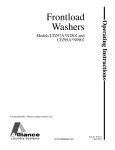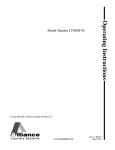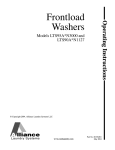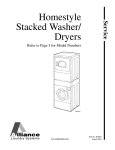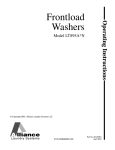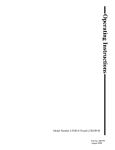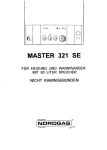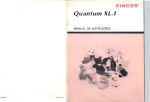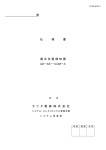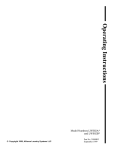Download Alliance Laundry Systems LTS99A*N1180 Operating instructions
Transcript
Operating Instructions Frontload Washers Models LTS97A*N, LTS97A*N1500, LTS99A*N, LTS99A*N1180, LTZ97A*N, LTZ99A*N, LTU97A*N and LTU99A*N © Copyright 2005, Alliance Laundry Systems LLC www.comlaundry.com Part No. 801507R1 April 2005 Operating Instructions SWD606N SPIN ONLY Cycle WARNING To reduce the risk of fire, electric shock, serious injury or death to persons, read the IMPORTANT SAFETY INSTRUCTIONS in the Use and Care Guide before operating your washer. W018E NOTE: Always follow manufacturer’s care labels. Determine Proper Cycle REGULAR Cycle Use for sturdy items, like play or work clothes, towels, T-shirts, etc. This cycle includes a wash tumble for nine minutes. The cycle has two rinses with an optional third rinse. The final spin starts with a twominute medium spin and finishes with a three-minute high spin. The total cycle time is approximately 29 minutes without the extra rinse. PERMANENT PRESS Cycle Use for permanent press items and synthetics. This cycle includes a wash tumble of seven minutes. The cycle has two rinses with an optional third rinse. The final spin starts with a three-minute medium spin and finishes with a two-minute high spin. The total cycle time is approximately 27 minutes without the extra rinse. Use to extract water from wet items. This cycle uses the high spin. The total cycle time is approximately 10 minutes. To Wash Clothes IMPORTANT: Before using your new washer, make sure the washer cord is plugged into a 120 Volt electrical outlet that has the proper grounding and polarity. Make sure the washer hoses are connected to the hot and cold water faucets, and that the faucets are turned on. Be sure the drain hose is not kinked and is inserted into a drain. Refer to the INSTALLATION INSTRUCTIONS for details of proper washer installation. IMPORTANT: Prior to first wash, use an allpurpose cleaner, or a detergent and water solution, and a damp cloth to remove shipping dust from inside of washtub. IMPORTANT: Remove all sharp objects from laundry to avoid tears and rips to items during normal machine operation. 1. Get the clothes ready for washing. Empty pockets and cuffs. Sort items into separate loads. Pretreat stains and heavily soiled areas. DELICATE Cycle Wash delicate items usually washed by hand on this cycle. The cycle includes a wash tumble of five minutes. The cycle has two rinses with an optional third rinse. The final spin extracts moisture at a low spin for four minutes. The total cycle time is approximately 23 minutes without the extra rinse. D305I RINSE & SPIN Cycle Use to quickly rinse items. The rinse is followed by a high spin. The total cycle time is approximately 12 minutes. 2 © Copyright, Alliance Laundry Systems LLC – DO NOT COPY or TRANSMIT 801507 2. Measure and add low sudsing detergent, fabric softener, and bleach to the dispenser drawer. Refer to section on Using Your Dispenser Drawer. WARNING To reduce the risk of serious injury, do not bypass the loading door switch by permitting the washer to tumble or spin with the loading door open. W095 5. Set WASH/RINSE temperatures. TEMPERATURE WARM WARM SWD725N IMPORTANT: If using detergents made for topload washers, avoid oversudsing by using only 1/4 cup regular detergent (1/2 of the recommended amount). 3. Load clothes into wash drum. Refer to section on Load Sizes in your Use and Care Guide. HOT COLD WARM COLD COLD COLD FLW1931N There are four WASH/RINSE temperatures available – Hot Wash/Cold Rinse, Warm Wash/Warm Rinse, Warm Wash/Cold Rinse, and Cold Wash/Cold Rinse. Refer to the Available Water Temperatures section for the temperature that works best for your garments. WARNING Window may be hot in the Hot Wash Cycle. W326E 6. Select EXTRA RINSE if desired. SWD726N 4. Close the loading door tightly. The washer will not operate with the loading door open. W547I The extra rinse control is useful for detergent sensitive skin. By pressing the EXTRA RINSE to ON, the REGULAR, PERMANENT PRESS, and DELICATE cycles will each provide an additional rinse. If the extra rinse is desired, press the switch to ON. When the extra rinse is not wanted, OFF should be selected. SWD727N 801507 © Copyright, Alliance Laundry Systems LLC – DO NOT COPY or TRANSMIT 3 7. Select the cycle according to the type of fabric being washed. Use the indicator dot on the knob as a guide. CYCLE SELECTION OFF SPIN ONLY 5. Press and hold the START button for two seconds. To change the cycle after the first wash is complete: NOTE: This should only be done if the speed of the final extract is incorrect for the fabric being washed. For example, if washing delicate items on the REGULAR cycle, the high speed extract may damage the fabric. Or, if washing towels or jeans on the DELICATE cycle, the lower speed extract would increase drying time. REGULAR RINSE & SPIN 4. Turn on extra rinse, if desired. PERMANENT PRESS DELICATE FLW1932N 8. Press and hold the START button for two seconds to start the washer. The DOOR light will come on after a short delay, water fill will begin, and wash drum will begin tumbling. NOTE: Washer door MUST be closed tightly to start washer. If items need to be added or removed after a cycle has started, turn the Cycle Selector knob to the OFF position. Wait until the DOOR light goes off (approximately 45 seconds after cycle has been stopped), open door, add or remove items, and start the cycle again. 1. Abort the current cycle by changing the cycle selector switch to the OFF position. 2. Restart the cycle from the beginning. Refer to the To Wash Clothes section. To Pump Out Water After Aborting Cycle Run a SPIN ONLY cycle. This cycle will perform a high speed extract operation that will pump all of the water out of the washer. DOOR Light When the washer is started, the DOOR light will come on after a short delay. The light will turn off approximately 45 seconds after the cycle is complete. There is no agitator on this washer. Instead, the clothing gently tumbles through the water. The wash action consists of a period of tumbling in one direction, a brief pause, and then a reverse tumble in the opposite direction. The pauses are part of the tumble action and add to the uniqueness of the washer. They are part of the cycle. WASH Light To Change Cycles FINAL SPIN Light If the selected cycle is not the correct cycle for the fabric being washed, you may change the cycle selection at any time until the first wash fill is complete. Once the washer has filled for the first part of the cycle (the wash portion), the current cycle must be aborted and a new cycle must be started. This light comes on while the wash load is in the final spin of the cycle. This light comes on during the wash part of each cycle. RINSE Light This light comes on for the rinse portion of each cycle. Out of Balance Load Change the cycle selected on the cycle selector switch. If at the end of the cycle, the load is dripping wet, the washer has limited the spin speed. This is to prevent damage to the unit if there is a severely unbalanced load. To change the cycle after the first fill is complete and before the first wash is complete: If this condition occurs, redistribute the load manually and run a RINSE & SPIN cycle. To change the cycle before the first fill is complete: 1. Abort the current cycle by changing the cycle selector switch to the OFF position. If the condition persists, consider steps discussed in the Before Washing section of the Use and Care Guide. 2. Set the WASH/RINSE temperature selector. 3. Set cycle selector. 4 © Copyright, Alliance Laundry Systems LLC – DO NOT COPY or TRANSMIT 801507 Available Washing Cycles The cycles of your washer include several different settings. Refer to Table 1 for what can be expected during the cycles that you select. Regular Cycle Activity Water Temperatures Wash Fill & Tumble (9:00) Hot, Warm or Cold Spin Pulse Spin Rinse Fill & Tumble Spin Pulse Spin Extra Rinse (Optional) Fill & Tumble Spin Pulse Spin Final Rinse Fill & Tumble Spin Pulse Spin Spin Medium Spin (650 rpm) Final Spin High Spin (1000 rpm) Fluff Tumble Cold Cold Warm or Cold Permanent Press Cycle Activity Water Temperatures Wash Fill & Tumble (7:00) Hot, Warm or Cold Spin Pulse Spin Rinse Fill & Tumble Spin Pulse Spin Extra Rinse (Optional) Fill & Tumble Spin Pulse Spin Final Rinse Fill & Tumble Spin Pulse Spin Spin Medium Spin (650 rpm) Final Spin High Spin (1000 rpm) Fluff Tumble Cold Cold Warm or Cold Table 1 (continued) 801507 © Copyright, Alliance Laundry Systems LLC – DO NOT COPY or TRANSMIT 5 Table 1 (continued) Delicate Cycle Activity Water Temperatures Wash Fill & Tumble (5:00) Hot, Warm or Cold Spin Pulse Spin Rinse Fill & Tumble Spin Pulse Spin Extra Rinse (Optional) Fill & Tumble Spin Pulse Spin Final Rinse Fill & Tumble Spin Pulse Spin Final Spin Low Spin (500 rpm) Fluff Tumble Cold Cold Warm or Cold Rinse & Spin Cycle Activity Water Temperatures Rinse Fill & Tumble (2:00) Warm or Cold Spin Pulse Spin Spin Medium Spin (650 rpm) Final Spin High Spin (1000 rpm) Fluff Tumble NOTE: The Rinse setting will give a cold rinse when the optional Extra Rinse is selected. 6 © Copyright, Alliance Laundry Systems LLC – DO NOT COPY or TRANSMIT 801507 Using Your Dispenser Drawer Use liquid bleach in the dispenser. Powdered bleach must not be used in this compartment. Powdered bleach can be used in the detergent compartment only and can be added along with the detergent. DO NOT use more than the maximum level indicated for the bleach compartment. Adding more than the maximum amount could result in early dispensing of the product and possible damage to fabrics. 3 2 1 Carefully pour recommended amount of bleach into the compartment before starting wash load. Be careful not to spill undiluted bleach. It is a strong chemical and can damage some fabrics if it is not properly diluted. Follow bleach manufacturer’s label for proper use. Carefully close dispenser door. Do not allow bleach to spill into other compartments. SWD728N 1 2 3 Detergent Bleach Fabric Softener Detergent Compartment Fabric Softener Compartment The fabric softener compartment is located in the left rear corner of the dispenser drawer. Refer to compartment 3 of illustration. The detergent compartment is located on the right side of the dispenser drawer. Refer to compartment 1 of illustration. Use no more than the maximum level indicated for the fabric softener compartment. Adding more than the maximum amount could result in early dispensing of the product and possible staining of fabrics. Use low sudsing powdered or liquid detergents that are recommended for use with high efficiency or front loading washers. Powdered bleach can also be used in the dispenser along with the detergent. Add fabric softener to compartment before beginning washload. The fabric softener will be dispensed during the last rinse cycle. NOTE: If using detergents made for topload washers, avoid oversudsing by using 1/2 of the recommended amount. When adding detergent, use only the recommended amount. Adding too much detergent or using regular sudsing detergent could result in an oversudsing condition, which would require additional rinsing with cold water. Use care when adding detergent so as not to spill into the other compartments. Detergent mixed with fabric softener can make the softener gummy. NOTE: The normal level of suds should be below center of the door. Carefully close dispenser door. Do not allow softener to spill into other compartments. To Clean the Dispenser Remove the dispenser drawer from the washer by firmly pulling the drawer straight out, past the stop position. Rinse dispenser drawer in hot water. A small brush may be used to thoroughly clean out any residue. After cleaning, reinstall the dispenser drawer. From time to time, water may be discovered in the dispenser drawer. This condition is normal. To remove the water, simply remove the dispenser drawer and pour out the water. Liquid Bleach Compartment The bleach compartment is located in the left front corner of the dispenser drawer. Refer to compartment 2 of illustration. It has been designed to prevent the dispensing of undiluted bleach onto the clothes load. 801507 © Copyright, Alliance Laundry Systems LLC – DO NOT COPY or TRANSMIT 7 Available Water Temperatures The Cold Wash is ideal for delicate items. Although its cleaning abilities are not as great as with hot or warm water, it is useful for colors that bleed easily and for sensitive fabrics. The Hot Wash temperature is determined by the actual temperature of the hot water supplied to the washer. Hot water is the most effective for cleaning, but it is not recommended for all fabric types (read labels). The Cold Rinse is optional in every cycle and is the most beneficial for fabrics. Cold rinses reduce wrinkling and color fading. In addition, cold rinses will save money and energy. The Warm Wash is useful for providing a thorough cleaning on lightly soiled clothing without damaging fabric or adding to color fading. NOTE: Always follow manufacturer’s care labels. The Warm Rinse is useful in preventing wrinkles on certain fabrics. Check labels for fabric manufacturer’s recommendations. Hot Approximately 120°F (49°C) (or as determined by outside hot water supply) ● ● ● ● ● Warm Approximately 100°F (38°C) ● ● ● ● Cold Approximately 65°F (18°C) 8 ● ● ● Sturdy whites and colorfast items. Work clothes. Heavily soiled items. Diapers. Light and moderately soiled items. Non-colorfast or dark colors. Permanent press. Silks, woolens, nylon, acrylic. Rinsing of some items. Non-colorfast items. Extra delicate clothing. Rinsing of most items. © Copyright, Alliance Laundry Systems LLC – DO NOT COPY or TRANSMIT 801507 Instrucciones de operación Lavadoras de carga frontal Modelos LTS97A*N, LTS97A*N1500, LTS99A*N, LTS99A*N1180, LTZ97A*N, LTZ99A*N, LTU97A*N y LTU99A*N © Copyright 2005, Alliance Laundry Systems LLC www.comlaundry.com Pieza No. 801507R1 Abril 2005 Instrucciones de operación SWD606N Ciclo DELICATE (Delicado) ADVERTENCIA Para reducir el riesgo de incendios, descargas eléctricas y lesiones graves o letales, lea las INSTRUCCIONES IMPORTANTES DE SEGURIDAD de la Guía de uso y cuidado antes de utilizar la lavadora. W018SB NOTA: Siempre observe las instrucciones del fabricante para el cuidado de la prenda que aparecen en la etiqueta. Con este ciclo puede lavar artículos delicados que generalmente se lavan a mano. Este ciclo incluye un agitado de lavado de cinco minutos. El ciclo tiene dos aclarados con un tercer aclarado opcional. El centrifugado final extrae la humedad con un centrifugado de baja velocidad de cuatro minutos. El tiempo total del ciclo es de aproximadamente 23 minutos sin el aclarado adicional. Ciclo RINSE & SPIN (Aclarado y centrifugado) Determinación el ciclo adecuado Se usa para un aclarado rápido de las prendas. El aclarado es seguido de un centrifugado de velocidad alta. El tiempo total del ciclo es de aproximadamente 12 minutos. Ciclo REGULAR (Normal) Ciclo SPIN ONLY (Centrifugado solamente) Uso para artículos robustos como ropas de juego o de trabajo, toallas, camisetas, etc. Este ciclo incluye un agitado de lavado de nueve minutos. El ciclo tiene dos aclarados con un tercer aclarado opcional. El centrifugado final comienza con un centrifugado de velocidad media de dos minutos y termina con uno de velocidad alta de tres minutos. El tiempo total del ciclo es de aproximadamente 29 minutos sin el aclarado adicional. Se usa para extraer el agua de las prendas húmedas. Este ciclo emplea el centrifugado de velocidad alta. El tiempo total del ciclo es de aproximadamente 10 minutos. Ciclo PERMANENT PRESS (Planchado permanente) Uso para artículos de planchado permanente y prendas sintéticas. Este ciclo incluye un agitado de lavado de siete minutos. El ciclo tiene dos aclarados con un tercer aclarado opcional. El centrifugado final comienza con un centrifugado de velocidad media de tres minutos y termina con uno de velocidad alta de dos minutos. El tiempo total del ciclo es de aproximadamente 27 minutos sin el aclarado adicional. Lavado de la ropa IMPORTANTE: Antes de usar su nueva lavadora, asegúrese de que esté enchufada en un tomacorriente de 120 voltios que tenga la debida conexión a tierra y la polaridad correcta. Asimismo, asegúrese de que las mangueras de la lavadora estén conectadas a los grifos de agua caliente y fría, y que éstos estén abiertos. Cerciórese de que la manguera de drenaje no esté torcida y esté insertada en un desagüe. Consulte las INSTRUCCIONES DE INSTALACIÓN para obtener más información sobre la instalación correcta de la lavadora. IMPORTANTE: Antes del primer lavado, use un limpiador de uso general o una solución de detergente y agua y un paño húmedo para remover el polvo de la tina de la lavadora acumulado durante su transporte. IMPORTANTE: Retire todo objeto cortante de la ropa a lavar para evitar rasguños o desperfectos en las prendas durante la operación normal de la máquina. 2 © Copyright, Alliance Laundry Systems LLC – DO NOT COPY or TRANSMIT 801507 (SP) 1. Prepare la ropa a lavar. Vacíe los bolsillos y los dobleces. Divida las prendas en cargas separadas. Trate previamente las manchas y las partes muy sucias. 4. Cierre bien la puerta de carga. La lavadora no funcionará si la puerta permanece abierta. D305I 2. Mida y agregue detergente de baja espuma, suavizador de tela y blanqueador en el alojamiento del surtidor. Consulte la sección Uso del compartimiento del surtidor. SWD727N ADVERTENCIA A fin de reducir el riesgo de lesiones graves, no anule el interruptor de la compuerta de carga que impide que la lavadora inicie su ciclo de agitación o centrifugado cuando la compuerta está abierta. W095SA SWD725N IMPORTANTE: Si usa detergentes elaborados especialmente para lavadoras que se cargan por la parte superior, use 1/4 taza de detergente (la mitad de la cantidad recomendada) para evitar el exceso de espuma. 3. Introduzca la ropa en la tina de lavado. Consulte la sección Tamaño de la carga en la Guia de uso y cuidado. 5. Ajuste las temperaturas de WASH/RINSE (Lavado/aclarado). TEMPERATURE WARM WARM HOT COLD WARM COLD COLD COLD FLW1931N Hay cuatro temperaturas de WASH/RINSE (Lavado/ aclarado) disponibles – Hot Wash/Cold Rinse (Lavado caliente/aclarado frío), Warm Wash/Warm Rinse (Lavado templado/aclarado templado), Warm Wash/ Cold Rinse (Lavado templado/aclarado frío) y Cold Wash/Cold Rinse (Lavado frío/aclarado frío). Consulte la sección de Temperaturas de agua disponibles donde aparecen las temperaturas más adecuadas para sus prendas. ADVERTENCIA SWD726N Es posible que la ventanilla se caliente durante el ciclo de Hot Wash (Lavado con agua caliente). W326S 801507 (SP) © Copyright, Alliance Laundry Systems LLC – DO NOT COPY or TRANSMIT 3 6. Seleccione EXTRA RINSE (Aclarado adicional) si lo desea. W547I El control de aclarado adicional es útil para pieles sensibles al detergente. Al pulsar EXTRA RINSE (Aclarado adicional) a la posición ON (Encendido), los ciclos REGULAR (Normal), PERMANENT PRESS (Plancha permanente) y DELICATE (Delicado) proporcionarán todos un aclarado adicional. Si se desea un aclarado adicional, pulse el interruptor a la posición ON (Encendido) Cuando no se desee el aclarado adicional, OFF (Apagado) deberá estar seleccionado. 7. Seleccione el ciclo según el tipo de tejido que se vaya a lavar. Use el punto indicador en la perilla como guía. Para cambiar los ciclos Si el ciclo seleccionado no es el correcto para el tejido que se está lavando, se puede cambiar la selección del ciclo en cualquier momento hasta que se complete el llenado de lavado. Una vez se haya llenado la lavadora para la primera parte del ciclo (la porción de lavado), el ciclo en curso deberá se abortado y deberá iniciarse un nuevo ciclo. Para cambiar el ciclo antes de que el primer llenado se haya completado: Cambie el ciclo seleccionado en el selector de ciclos. Para cambiar el ciclo después de que el primer llenado se haya completado y antes de que el primer lavado se haya completado: 1. Aborte el ciclo en curso cambiando el selector de ciclo a la posición OFF (Apagado). CYCLE SELECTION OFF SPIN ONLY Esta lavadora no cuenta con agitador. En su lugar, la ropa se agita dentro del agua. La acción de lavado consta de un período de agitado en una dirección, una breve pausa y un período de agitado en sentido contrario al primero. Las pausas forman parte de la acción de agitado de este exclusivo tipo de lavadora. No intente girar la perilla del temporizador para acortar estas pausas, ya que las mismas forman parte del ciclo. 2. Ajuste el selector de temperatura WASH/RINSE (Lavado/aclarado). REGULAR 3. Ajuste el selector de ciclo. RINSE & SPIN 4. Active el aclarado adicional si lo desea. PERMANENT PRESS 5. Pulse y mantenga pulsado el botón START (Inicio) durante dos segundos. DELICATE FLW1932N 8. Pulse mantenga pulsado el botón START (Inicio) durante dos segundos para arrancar la lavadora. La luz de DOOR (Puerta) se encenderá después de una corta pausa, comenzará el llenado del agua y el tambor de lavado empezará a agitarse. NOTA: La puerta de la lavadora DEBERÁ estar bien cerrada para que ésta arranque. Si se necesita añadir o retirar prendas después de iniciado un ciclo, gire la perilla del selector de ciclos a la posición OFF (Apagado). Espere hasta que se apague la luz de DOOR (Puerta) (aproximadamente 45 segundos después de pararse el ciclo), abra la puerta, añada o retire las prendas, e inicie el ciclo de nuevo. 4 Para cambiar el ciclo después de que el primer lavado se haya completado: NOTA: Esto deberá hacerse únicamente si la velocidad de la extracción final es incorrecta para el tejido que se esté lavando. Por ejemplo, si se están lavando prendas delicadas en el ciclo REGULAR (Normal), la velocidad alta de extracción podría dañar los tejidos. O, si se están lavando toallas o pantalones vaqueros en el ciclo DELICATE (Delicado), una velocidad baja de extracción aumentaría el tiempo de secado. 1. Aborte el ciclo en curso cambiando el selector de ciclo a la posición OFF (Apagado). 2. Vuelva a iniciar el ciclo desde el principio. Consulte la sección Para lavar ropa. © Copyright, Alliance Laundry Systems LLC – DO NOT COPY or TRANSMIT 801507 (SP) Para extraer el agua después de haber abortado un ciclo Active un ciclo SPIN ONLY (Centrifugado solamente). El ciclo realizará una operación de extracción a alta velocidad que bombeará toda el agua fuera de la lavadora. Luz DOOR (Puerta) Cuando se arranca la lavadora, se enciende la luz de DOOR (Puerta) después de una corta pausa. La luz se apagará automáticamente 45 segundos después de completarse el ciclo. Luz WASH (Lavado) La luz se enciende durante la parte de lavado de cada ciclo. Luz FINAL SPIN (Centrifugado final) La luz se enciende cuando la carga de lavado se encuentra en el centrifugado final del ciclo. Carga fuera de balance Si al final del ciclo la carga todavía está cargada de agua al punto de gotear, significa que la lavadora limitó la velocidad de centrifugado para evitar daño a la unidad en casos de un desbalance considerable de la carga. Si se diese esta condición, vuelva a distribuir la carga manualmente y active un ciclo RINSE & SPIN (Aclarado y centrifugado). Si la situación persiste, considere los pasos descritos en la sección Antes de lavar en la Guia de uso y cuidado. Luz RINSE (Aclarado) La luz se enciende durante la parte de aclarado de cada ciclo. 801507 (SP) © Copyright, Alliance Laundry Systems LLC – DO NOT COPY or TRANSMIT 5 Ciclos de lavado disponibles Los ciclos de la lavadora cuentan con varios ajustes diferentes. Consulte la Tabla 1 siguientes para conocer lo que ocurre durante los ciclos que seleccione. Ciclo Regular (Normal) Descripción Actividad Temperaturas del agua Wash (Lavado) Llenado y agitado (9:00) Caliente, tibia, fría Spin (Centrifugado) Centrifugado de pulso Rinse (Aclarado) Llenado y agitado Spin (Centrifugado) Centrifugado de pulso Extra Rinse (Aclarado adicional [opcional]) Llenado y agitado Spin (Centrifugado) Centrifugado de pulso Final Rinse (Aclarado final) Llenado y agitado Spin (Centrifugado) Centrifugado de pulso Spin (Centrifugado) Centrifugado medio (650 rpm) Final Spin (Centrifugado final) Centrifugado alto (1000 rpm) Fluff (Mullido) Agitado Fría Fría Tibia o fría Ciclo de Permanent Press (Planchado permanente) Descripción Actividad Temperaturas del agua Wash (Lavado) Llenado y agitado (7:00) Caliente, tibia, fría Spin (Centrifugado) Centrifugado de pulso Rinse (Aclarado) Llenado y agitado Spin (Centrifugado) Centrifugado de pulso Extra Rinse (Aclarado adicional [opcional]) Llenado y agitado Spin (Centrifugado) Centrifugado de pulso Final Rinse (Aclarado final) Llenado y agitado Spin (Centrifugado) Centrifugado de pulso Spin (Centrifugado) Centrifugado medio (650 rpm) Final Spin (Centrifugado final) Centrifugado alto (1000 rpm) Fluff (Mullido) Agitado Fría Fría Tibia o fría Tabla 1 (continuado) 6 © Copyright, Alliance Laundry Systems LLC – DO NOT COPY or TRANSMIT 801507 (SP) Tabla 1 (continuado) Ciclo Delicate (Delicado) Descripción Actividad Temperaturas del agua Wash (Lavado) Llenado y agitado (5:00) Caliente, tibia, fría Spin (Centrifugado) Centrifugado de pulso Rinse (Aclarado) Llenado y agitado Spin (Centrifugado) Centrifugado de pulso Extra Rinse (Aclarado adicional [opcional]) Llenado y agitado Spin (Centrifugado) Centrifugado de pulso Final Rinse (Aclarado final) Llenado y agitado Spin (Centrifugado) Centrifugado de pulso Final Spin (Centrifugado final) Centrifugado bajo (500 rpm) Fluff (Mullido) Agitado Fría Fría Tibia o fría Ciclo Rinse & Spin (Aclarado y centrifugado) Descripción Actividad Temperaturas del agua Rinse (Aclarado) Llenado y agitado (2:00) Tibia o fría Spin (Centrifugado) Centrifugado de pulso Spin (Centrifugado) Centrifugado medio (650 rpm) Final Spin (Centrifugado final) Centrifugado alto (1000 rpm) Fluff (Mullido) Agitado NOTA: El ajuste Rinse (Aclarado) proporcionará un aclarado en frío cuando se haya seleccionado la opción Extra Rinse (Aclarado adicional). 801507 (SP) © Copyright, Alliance Laundry Systems LLC – DO NOT COPY or TRANSMIT 7 Empleo del compartimiento del surtidor NO llene el compartimiento a un nivel superior al indicado en el compartimiento de blanqueador. Si agrega una cantidad superior a la máxima el producto podría ser administrado demasiado pronto y dañar las telas. 3 2 Emplee blanqueador líquido en el surtidor. No deberá utilizar blanqueador en polvo en este compartimiento, sino únicamente en el compartimiento del detergente. En este caso, puede agregarse junto con el detergente. 1 Vierta con cuidado la cantidad recomendada de blanqueador dentro del compartimiento antes de iniciar el lavado de la carga. Evite derramar blanqueador sin diluir. Éste es un producto químico fuerte que podría dañar algunas telas si no se disuelve adecuadamente. Aplique el procedimiento adecuado siguiendo las instrucciones que aparecen en las etiquetas de los fabricantes. SWD728N 1 2 3 Detergente Blanqueador Suavizador Compartimiento del suavizador de tela Compartimiento del detergente El compartimiento del detergente está localizado en el lado derecho del compartimiento del surtidor. Consulte el compartimiento 1 de la ilustración. Emplee detergentes en polvo o líquidos de baja espuma, recomendados para usar con lavadoras de alta eficiencia o de carga frontal. También puede usarse blanqueador en polvo en el surtidor junto con el detergente. NOTA: Si emplea detergente para lavadoras de carga por la parte superior, evite que se produzca una espuma excesiva utilizando la media parte de la cantidad recomendada. Al agregar el detergente, utilice solamente la cantidad recomendada. Agregar demasiado detergente o detergente de espuma normal podría producir una espuma excesiva, la cual requerirá un enjuague adicional con agua fría. Agregue detergente con cuidado, evitando que no caiga en los otros compartimientos. Si el detergente se mezcla con el suavizador de tela, éste último podría tornarse pegajoso. NOTA: El nivel normal de espuma está por debajo del centro de la puerta. Compartimiento de blanqueador líquido El compartimiento de blanqueador está localizado en la esquina delantera izquierda del compartimiento del surtidor. Consulte el compartimiento 2 de la ilustración. Este compartimiento se ha diseñado para evitar que se suministre blanqueador sin diluir sobre la carga de ropa. 8 Cierre con cuidado la puerta del surtidor. No permita que caiga blanqueador en otros compartimientos. El compartimiento del suavizador de tela está ubicado en la esquina trasera izquierda del compartimiento del surtidor. Consulte el compartimiento 3 de la ilustración. No llene el compartimiento a un nivel superior al indicado en el compartimiento del suavizador de tela. Si agrega una cantidad superior a la máxima el producto podría ser administrado demasiado pronto y marchar las telas. Ponga el suavizador de tela en el compartimiento antes de comenzar el lavado de la carga. El suavizador de tela será administrado durante el ciclo de enjuague final. Cierre con cuidado la puerta del surtidor. No permita que caiga suavizador en otros compartimientos. Limpieza del surtidor Saque de la lavadora el compartimiento del surtidor tirando firmemente hacia fuera más allá de la posición abierta. Enjuague el compartimiento del surtidor con agua caliente. Puede utilizar un cepillo para eliminar los residuos. Reinstale el compartimiento del surtidor después de limpiarlo. De vez en cuando, es posible que se acumule un poco de agua en el compartimiento del surtidor. Esta condición es normal. Para sacar el agua, simplemente saque el compartimiento del surtidor y bote el agua que contiene. © Copyright, Alliance Laundry Systems LLC – DO NOT COPY or TRANSMIT 801507 (SP) Temperaturas de agua disponibles El lavado con agua fría es ideal para artículos delicados. Aun cuando su capacidad de limpieza no es tan alta como la del agua caliente o tibia, es útil para lavar artículos de colores que se destiñen fácilmente y telas sensibles. La temperatura de lavado con agua caliente está determinada por la temperatura del agua caliente suministrada a la lavadora. El agua caliente proporciona los mejores resultados en términos de limpieza, pero no es recomendable para todas las prendas (lea las etiquetas). El enjuague con agua fría es opcional en cada ciclo y es el más beneficioso para las telas. El enjuague con agua fría reduce las arrugas y las pérdidas de color. Asimismo, contribuye a ahorrar dinero y energía eléctrica. El lavado con agua tibia proporciona una limpieza profunda de ropa ligeramente sucia sin dañar la tela o hacerle perder el color. NOTA: Siempre observe las recomendaciones del fabricante para el cuidado de la prenda que aparecen en la etiqueta. El enjuague con agua tibia evita las arrugas en ciertos tipos de tela. Observe las recomendaciones del fabricante para el cuidado de la prenda que aparecen en la etiqueta. Caliente Aproximadamente 49° C (120° F) ● (o determinada por el suministro externo de agua caliente) ● ● ● ● Tibia Aproximadamente 38° C (100° F) ● ● ● ● Fría Aproximadamente 18° C (65° F) 801507 (SP) ● ● ● Blancos resplandecientes y ropa de color firme. Ropa de trabajo. Ropa muy sucia. Pañales. Para prendas ligera y moderadamente sucias. Colores oscuros y que destiñen. Planchado permanente. Sedas, lanas, nylon y acrílicos. Para enjuagar algunos artículos. Telas que destiñen. Ropa muy delicada. Para enjuagar la mayoría de las prendas. © Copyright, Alliance Laundry Systems LLC – DO NOT COPY or TRANSMIT 9


















